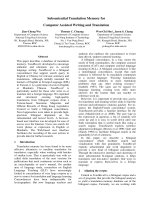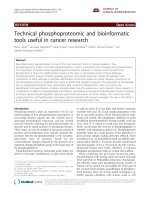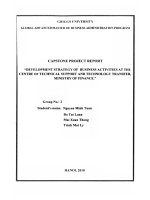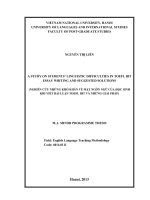technical writing and presentation title virtual plcs containerized controllers
Bạn đang xem bản rút gọn của tài liệu. Xem và tải ngay bản đầy đủ của tài liệu tại đây (423.47 KB, 12 trang )
<span class="text_page_counter">Trang 1</span><div class="page_container" data-page="1">
HANOI UNIVERSITY OF SCIENCE AND TECHNOLOGYSCHOOL OF ELECTRICAL & ELECTRONIC ENGINEERING
TECHNICAL WRITING AND PRESENTATION TITLE:
”Virtual PLCs - Containerized controllers”
Name Student IDNguyen Tuan Hung 20202634
Pham Chi Hieu 20202747Ma Tien Huan 20202395Nguyen Phung Hung 20181508
Automation Control Engineering
Instructor: PhD. Nguyen Hoang Nam
<small>Signature of Supervisor</small>
Department: Department of Automation
School: School of electrical & electronic engineering
Hanoi, 01/2024
</div><span class="text_page_counter">Trang 2</span><div class="page_container" data-page="2">I had a wonderful experience during my three years at Hanoi University of Scienceand Technology. It is both a long time and a difficult challenge, but it is almost overthanks to PhD. Nguyen Hoang Nam, my friends and my teammate.
I was able to better understand the specific tasks the Virtual PLCs - Containerizedcontrollers thanks to the project completion process, independent working methods, cre-ativity, science and discipline.
The thesis also has many significant errors due to limited time available for pletion and limited expertise. Hopefully everything will be pointed out to fix, and mythesis could be better.
The Virtual PLC (Programmable Logic Controller) holds significant importance intoday’s world, particularly in the field of industrial automation and control systems. Dueto the emerging role of virtual PLC, many researches has been conducted to study thedevelopment of Virtual PLC and its effect on modern life. By using data from variousresearch paper about the application of Virtual PLC in some particular field, this paperwill decompose the matter of Virtual PLC into parts due to (a)Advantages and drawbacksof Virtual PLC, and (b) Future trends of the Virtual PLC. Corresponding to what hasoften been assumed, the focus on Virtual PLC amongst researcher is largely attributableto its effectiveness in various industries. This paper indicates thaT...
</div><span class="text_page_counter">Trang 3</span><div class="page_container" data-page="3">LIST OF FIGUIRELIST OF TABLES
CHAPTER 2. ADVANTAGES AND DISADVANTAGES OF VIRTUAL PLCs. 3
2.1 Advantages . . . . 3
2.1.1 Advantages of Virtual PLCs in Automation field [2] . . . . 3
2.1.2 Advantages of Virtual PLCs in various fields. . . . 4
2.2 Disadvantages . . . . 4CHAPTER 3. FUTURE TREND WITH VIRTUAL PLCs. 6
</div><span class="text_page_counter">Trang 4</span><div class="page_container" data-page="4">List of Figures
Figuire 1.1 Virtual PLCs [x] . . . . 1
</div><span class="text_page_counter">Trang 5</span><div class="page_container" data-page="5">List of Tables
</div><span class="text_page_counter">Trang 6</span><div class="page_container" data-page="6">CHAPTER 1. INTRODUCTION
A Virtual PLC (Programmable Logic Controller) is a software-based emulation ofa physical PLC, designed to replicate the functionality of traditional hardware PLCs ina virtual environment. PLCs are critical components in industrial automation and con-trol systems, used to monitor and control various processes in manufacturing, energy,and other industries. Given that PLC application technology constitutes practical andextensive professional coursework, the significance of experimental teaching cannot beoverstated. Currently, there are two types of PLC experimental platforms employed ineducational settings: one utilizes actual controlled objects and PLC hardware, incorpo-rating real components, resulting in high maintenance and update costs. The alternativeapproach involves a virtual controlled object.
Picture 1.1Virtual PLCs [x]
Nevertheless, each of the aforementioned PLC experimental platforms possessesits own drawbacks. The former entails elevated initial investment as well as ongoingmaintenance and update expenses. The latter, reliant on real PLC hardware to demon-strate the operational status of peripheral devices. Addressing these issues, this paper
1
</div><span class="text_page_counter">Trang 7</span><div class="page_container" data-page="7">introduces a virtual scheme exclusively based on software for PLC. Virtual PLCs vide a cost-effective and flexible alternative to physical PLCs for training, testing, anddevelopment purposes. These software-based PLCs run on standard computers and sim-ulate the behavior of real-world PLCs, allowing users to create and test control programswithout the need for physical hardware.
pro-2
</div><span class="text_page_counter">Trang 8</span><div class="page_container" data-page="8">CHAPTER 2. ADVANTAGES AND DISADVANTAGES OFVIRTUAL PLCs.
This section covers the advantages and disadvantages of Virtual PLCs. Also tioned are its applications in various fields.
men-2.1 Advantages
2.1.1 Advantages of Virtual PLCs in Automation field [2]
• Flexibility: In Industry 4.0, more and more emphasis is placed on ad hoc solutionsfor each company or activity. These customizations, however, involve program-ming the PLCs every time a new specific product is requested. Which, obviously,lengthens production cycles. Virtual PLCs, on the other hand, allow you to per-form multiple configurations for different customizations at the same time. Thistranslates into time savings and more efficient use of resources only on-demand.• Scalability: Conventional PLCs pose several challenges to plants that want to ex-
pand due to their size and available space. Virtualization makes it possible to pand your automation processes by developing and testing new control strategiesbefore implementing them on physical PLCs. This reduces costs and risks of errorduring expansion.
ex-• Efficiency: With virtual PLCs they are integrated into industrial edge computingand make it possible to separate hardware and software. This allows you to manageapplications centrally and automate process phases in a data-centric and software-based way. [2]
• Reduced costs: Virtual PLCs eliminate or reduce several costs. First, hardwarecosts, since you no longer need to purchase hardware or physical hardware compo-nents, such as controllers, modules, and cabling. As a result, maintenance and hard-ware replacement costs are also eliminated. Being software-based, virtual PLCs canbe upgraded more easily.
• Remote access and monitoring: The ability to access and monitor virtual PLCsremotely decreases the need for on-site personnel. In addition to cutting costs, it isparticularly useful in situations where the plant or industrial devices are located ininaccessible or dangerous places.
• Training and simulation: One of the main advantages of virtual PLCs concerns thefield of training and simulation. Operators and employees can be trained in pro-gramming and using the PLC without the need to invest in often expensive hard-
3
</div><span class="text_page_counter">Trang 9</span><div class="page_container" data-page="9">ware configurations. Furthermore, virtual PLCs are easily integrated with tion software. Thus, development and testing can be performed without the needfor physical prototypes.
simula-2.1.2 Advantages of Virtual PLCs in various fields.
In various fields, Virtual PLCs (Virtual Programmable Logic Controllers) offernumerous advantages and benefits:
• Education: Virtual PLCs provide a secure learning environment for students andlearners to practice and develop programming and control skills without direct ex-posure to real-world equipment. Students can conveniently test the functionality ofPLCs from the comfort of their homes. Additionally, it enables students and re-searchers to explore, develop, and test new ideas more rapidly, reducing time andcosts compared to deployment on real systems. Virtual PLCs can also be employedto assess the performance and completeness of a model before its implementationin production.
• Environmental Protection: Utilizing Virtual PLCs to optimize control systems canreduce energy consumption in various facilities, thereby enhancing production ef-ficiency. Furthermore, system optimization significantly minimizes the impact onthe natural environment, contributing to environmental conservation.
• Entertainment: In the entertainment industry, particularly in cultural and artisticperformances, Virtual PLCs can be employed to simulate and test lighting andsound effects before implementing them in the final product.
• Healthcare: Virtual PLCs can be utilized to simulate medical devices and controlprocesses in a safe environment. This allows for the exploration of procedures,performance, and potential risks that the system may present before actual imple-mentation.
impos-4
</div><span class="text_page_counter">Trang 10</span><div class="page_container" data-page="10">• Integration Challenges with Real Devices: Users may encounter difficulties grating the simulation environment with real-world systems, especially when com-munication with actual devices and sensors is required.
inte-• Limitations or Unavailability in Simulation Capability: The simulation ment may face challenges when attempting to simulate large and complex systems,particularly when synchronizing multiple processes and devices is required.• High Initial Costs: Setting up a simulation environment and maintaining it re-
environ-quires a significant initial investment, including expenses for software, hardware,and skilled personnel.
• Security and Information Safety Concerns: Simulation environments may be posed to security risks when not adequately protected, particularly if connected tothe internet without proper configuration and monitoring for safety.
ex-5
</div><span class="text_page_counter">Trang 11</span><div class="page_container" data-page="11">CHAPTER 3. FUTURE TREND WITH VIRTUAL PLCs.
The applicability of Virtual PLCs is very high, their characteristics can providedifferent companies and organizations with the ability to have greater control over thenecessary resources, lower maintenance costs due to the location of the PLC hardwarein controlled environments, increase the physical security of the devices, improve PLCperformance control and increase convergence between IT and OT environments.
These types of new devices, developed in industry 5.0, have to be introduced ually in industrial environments, as their safety or performance characteristics have notbeen tested. Any new device has different vulnerabilities that can seriously affect theoperations of the environment, and that is why its use must be controlled, although it istrue that the characteristics of these virtual PLCs are promising.
grad-6
</div><span class="text_page_counter">Trang 12</span><div class="page_container" data-page="12">CHAPTER 4. CONCLUSION.
In this article, we have discussed the concept, benefits, and challenges of virtualPLCs, a new paradigm in industrial automation that can replace a large number of in-dividual controller ”boxes” and their electronics with virtualized PLCs on COTS in-frastructure. We have also reviewed some of the existing and emerging technologiesthat enable the implementation and operation of virtual PLCs, such as edge computing,SIMATIC S7-1500V, and fault detection and diagnosis. We have concluded that virtualPLCs offer significant advantages for the future of industrial automation and education,such as cost reduction, flexibility, scalability, learning, training, safety, and reliability.However, we have also acknowledged that virtual PLCs face some limitations, such ascomputing and network requirements, physical phenomena and interactions, and com-patibility and integration issues. Therefore, we have suggested that virtual PLCs needto be further developed and validated to overcome these challenges and achieve theirfull potential. We hope that this article has provided a comprehensive and informativeoverview of virtual PLCs and their role in the future of industrial automation.
7
</div>








